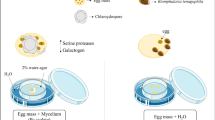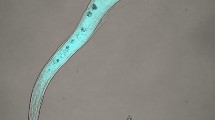Abstract
Cercariae of bird schistosomes (Trichobilharzia szidati and Trichobilharzia regenti) were mechanically stimulated to transform to schistosomula and kept in different cultivation media supplemented with duck red blood cells and/or homogenized nervous tissue. The development under in vitro conditions was compared with that in vivo, using the following characters: emptying of penetration glands, surface changes, food uptake, and growth of early schistosomula. The results show that the cultivation medium routinely used for human schistosomes is also suitable for mass production of early schistosomula of bird schistosomes, including the unique nasal species—T. regenti. The changes observed resemble those present in worms developing in vivo; therefore, the in vitro produced early schistosomula might be used for further studies of host–parasite interactions.







Similar content being viewed by others
Notes
Note: The European T. ocellata corresponds with T. szidati Neuhaus, 1952, but the North American isolates are not identical with T. szidati from Europe (Rudolfová et al. 2005).
References
Basch PF (1981) Cultivation of Schistosoma mansoni In vitro. I. Establishment of cultures from cercariae and development until pairing. J Parasitol 67(2):179–185
Blažová K, Horák P (2005) Trichobilharzia regenti: the developmental differences in natural and abnormal hosts. Parasitol Int 54:167–172
Bogitsh BJ (1993) The feeding of A type red blood cells in vitro and the ability of Schistosoma mansoni schistosomules to acquire A epitopes on their surfaces. J Parasitol 79(6):946–948
Bogitsh BJ, Carter OS (1977) Developmental studies on the digestive tract of schistosomules (Schistosoma mansoni) grown in vitro. I. Ultrastructure. Trans Am Microsc Soc 96(2):219–227
Bogitsh BJ, Carter OS (1979) Electron microscopic observations on Schistosoma mansoni schistosomules grown in vitro and in vivo. Trans Am Microsc Soc 98(3):454–460
Bourns TKR, Ellis JC, Rau ME (1973) Migration and development of Trichobilharzia ocellata (Trematoda: Schistosomatidae) in its duck hosts. Can J Zool 51:1021–1030
Chanova M, Vuong S, Horak P (2007) Trichobilharzia szidati: the lung phase of migration within avian and mammalian hosts. Parasitol Res 100(6):1243–1247
Clegg JA (1965) In vitro cultivation of Schistosoma mansoni. Exp Parasitol 16:133–147
Coustau C, Yoshino TP (2000) Flukes without snails: advances in the in vitro cultivation of intramolluscan stages of trematodes. Exp Parasitol 94:62–66
Dalton JP, Clough KA, Jones MK, Brindley PJ (1997) The cysteine proteinases of Schistosoma mansoni cercariae. Parasitology 114:105–112
de Gentile L, Picot H, Bourdeau P, Bardet R, Kerjan A, Piriou M, Le Guennic A, Bayssade-Dufour C, Chabasse D, Mott KE (1996) Cercarial dermatitis in Europe: a new public health problem? Bull World Health Organ 74(2):159–163
Farahnak A, Essalat M (2003) A study on cercarial dermatitis in Khuzestan province, south western Iran. BMC Pub Health 3:35
Fraser SJ, Allan SJR, Roworth M, Smith HV, Holme SA (2009) Cercarial dermatitis in the UK. Clin Exp Dermatol (in press) doi:10.1111/j.1365-2230.2008.02903.x
Haas W, Pietsch U (1991) Migration of Trichobilharzia ocellata schistosomula in the duck and in the abnormal murine host. Parasitol Res 77:642–644
Haas W, Diekhoff D, Koch K, Schmalfuss G, Loy C (1997) Schistosoma mansoni cercariae: stimulation of acetabular gland secretion is adapted to the chemical composition of mammalian skin. J Parasitol 83(6):1079–1085
Harrop R, Coulson PS, Wilson RA (1999) Characterization, cloning and immunogenicity of antigens released by lung-stage larvae of Schistosoma mansoni. Parasitology 118:583–594
Hockley DJ, McLaren DJ (1973) Schistosoma mansoni: changes in the outer membrane of the tegument during development from cercaria to adult worm. Int J Parasitol 3(1):13–25
Horák P (1995) Developmentally regulated expression of surface carbohydrate residues on larval stages of the avian schistosome Trichobilharzia szidati. Folia Parasitol 42:255–265
Horák P, Kolářová L (2000) Survival of bird schistosomes in mammalian lungs. Int J Parasitol 30:65–68
Horák P, Kolářová L (2001) Bird schistosomes: do they die in mammalian skin? Trends Parasitol 17(2):66–69
Horák P, Kolářová L, Dvořák J (1998a) Trichobilharzia regenti n. sp. (Schistosomatidae, Bilharzielinae), a new nasal schistosome from Europe. Parasite 5:349–357
Horák P, Kovář L, Kolářová L, Nebesářová J (1998b) Cercaria-schistosomulum surface transformation of Trichobilharzia szidati and its putative immunological impact. Parasitology 116:139–147
Horák P, Dvořák J, Kolářová L, Trefil L (1999) Trichobilharzia regenti, a pathogen of the avian and mammalian central nervous systems. Parasitology 119:577–581
Horák P, Kolářová L, Adema CM (2002) Biology of the schistosome genus Trichobilharzia. Adv Parasitol 52:155–233
Howell MJ, Bourns TK (1974) In vitro culture of Trichobilharzia ocellata. Int J Parasitol 4(5):471–476
Hrádková K, Horák P (2002) Neurotropic behaviour of Trichobilharzia regenti in ducks and mice. J Helminthol 76:137–141
Ivanchenko MG, Lerner JP, McCormick RS, Toumadje A, Allen B, Fischer K, Hedstrom O, Helmrich A, Barnes DW, Bayne CJ (1999) Continuous in vitro propagation and differentiation of cultures of the intramolluscan stages of the human parasite Schistosoma mansoni. Proc Natl Acad Sci U S A 96:4965–4970
Jenkins SJ, Hewitson JP, Ferret-Bernard S, Mountford AP (2005) Schistosome larvae stimulate macrophage cytokine production through TLR4-dependent and -independent pathways. Int Immunol 17(11):1409–1418
Kolářová L, Skirnisson K, Horák P (1999) Schistosome cercariae as the causative agent of swimmer’s itch in Iceland. J Helminthol 73(3):215–220
Kolářová L, Horák P, Čada F (2001) Histopathology of CNS and nasal infections caused by Trichobilharzia regenti in vertebrates. Parasitol Res 87:644–650
Mikeš L, Zídková L, Kašný M, Dvořák J, Horák P (2005) In vitro stimulation of penetration gland emptying by Trichobilharzia szidati and T. regenti (Schistosomatidae) cercariae. Quantitative collection and partial characterization of the products. Parasitol Res 96:230–241
Mountford AP, Harrop R, Wilson RA (1995) Antigens derived from lung-stage larvae of Schistosoma mansoni are efficient stimulators of proliferation and gamma interferon secretion by lymphocytes from mice vaccinated with attenuated larvae. Infect Immun 63(5):1980–1986
Rao VG, Dash AP, Agrawal MC, Yadav RS, Anvikar AR, Vohra S, Bhondeley MK, Ukey MJ, Das SK, Minocha RK, Tiwari BK (2007) Cercarial dermatitis in central India: an emerging health problem among tribal communities. Ann Trop Med Parasitol 101(5):409–413
Rudolfová J, Hampl V, Bayssade-Dufour C, Lockyer AE, Littlewood DTJ, Horák P (2005) Validity reassessment of Trichobilharzia species using Lymnaea stagnalis as the intermediate host. Parasitol Res 95:79–89
Smyth JD (1990) In vitro cultivation of parasiti helminths. In: Smyth JD (ed) In vitro cultivation of parasitic helminths. CRC, Boca Raton, pp 1–30
Valdovinos C, Balboa C (2008) Cercarial dermatitis and lake eutrophication in south-central Chile. Epidemiol Infect 136(3):391–394
van Bolhuis GH, Rijks JM, Dorrestein GM, Rudolfova J, van Dijk M, Kuiken T (2004) Obliterative endophlebitis in mute swans (Cygnus olor) caused by Trichobilharzia sp. (Digenea: Schistosomatidae) infection. Vet Pathol 41:658–665
Verbrugge LM, Rainey JJ, Reimink RL, Blankespoor HD (2004) Swimmer’s itch: incidence and risk factors. Am J Public Health 94(5):738–741
Acknowledgments
The work has been supported by the Czech Ministry of Education (MSM 0021620828 and MSM LC06009) and the Czech Science Foundation (206/06/0777). The authors declare that all the experiments reported in present study comply with the current laws of Czech Republic and EU.
Author information
Authors and Affiliations
Corresponding author
Rights and permissions
About this article
Cite this article
Chanová, M., Bulantová, J., Máslo, P. et al. In vitro cultivation of early schistosomula of nasal and visceral bird schistosomes (Trichobilharzia spp., Schistosomatidae). Parasitol Res 104, 1445–1452 (2009). https://doi.org/10.1007/s00436-009-1343-y
Received:
Accepted:
Published:
Issue Date:
DOI: https://doi.org/10.1007/s00436-009-1343-y




